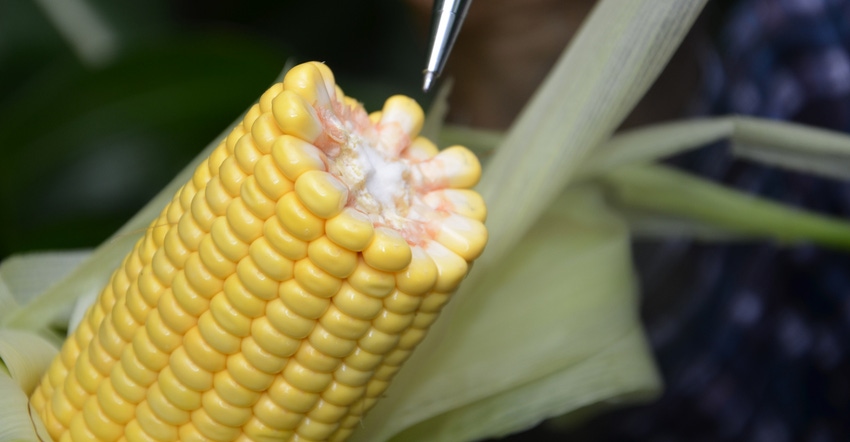
There are good fields of corn in the eastern Corn Belt. But even in many of those fields, a major question may not be answered until shortly before combines run. Will corn mature in time for drying so moisture is manageable? Most combine manufacturers and grain drying experts consider 24% to 28% moisture manageable, even though they classify it as high-moisture corn.
What about super-late-planted fields or areas within more timely planted fields but held up by soil compaction? Mother Nature holds all the cards, Dave Nanda says.
Nanda, director of genetics for Seed Genetics-Direct, Jeffersonville, Ohio, inspected the Corn Watch ’19 field on Aug. 21. Seed Genetics-Direct sponsors Corn Watch ’19.
The date is important because it ties into how much time this field needs to reach black layer, Nanda says. He suspects corn where he checked might not reach black layer until Oct. 1, more or less. That’s roughly 30% to 32% moisture, depending upon the hybrid.
“This field needs lots of heat units, measured in growing degree day units, and sunshine to both reach black layer and lose some extra moisture,” Nanda says. “Without them, we could be looking at harvesting very wet corn.”
Final stages
Normally, corn is dented by the last part of August. Indeed, there were fields where corn was dented. There were also fields still pollinating! This field was in between, somewhere approaching dough stage.
The Purdue University Corn and Soybean Field Guide outlines criteria for various reproductive stages for corn, based on where the milk line is and whether corn has dented, all the way until the black layer forms at the tip of the kernel, shutting off all further movement in and out of the kernel. That’s when corn is physiologically mature and safe from a killing freeze. Based on these descriptions, the ears Nanda examined in late August were likely at least 40 days from black layer.
Here are brief descriptions of reproductive stages:
Milk stage or R3. Kernels are mostly yellow and contain milky white, sugary fluid. This is the “roasting ear” stage, and moisture content is about 80%.
Dough stage or R4. The milky inner fluid changes to a doughy or pasty consistency as starch accumulates. Moisture content usually drops to about 70%. A milk line is still visible. Kernel abortion is now unlikely.
Dent stage or R5. All or nearly all kernels are denting near their crowns. Moisture at the beginning of the dent stage is around 60%. A distinct line between yellowish and whitish kernel tissue appears, known as the milk line. It appears near the dent end and moves toward the tip as kernels mature. It takes an average of 33 days from the beginning of the dent stage to reach black layer.
About the Author(s)
You May Also Like




